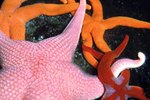
Even if you frequent the water in your area, chances are you may have never seen a wild map turtle. These distinctive, often heavy-jawed turtles tend to be secretive and shy away from their adoring public at the first sign of trespassers. Map turtles are quite an interesting group, and have a few distinguishing characteristics that separate them from their water-dwelling counterparts.
Map Origin
If you're wondering where the common name "map" turtle came from, look no further than the carapaces and bodies of these small turtles. Each has a series of thin lines that run in different directions and connect, looking similar to a detailed road map. The lines sometimes are broken up by irregularly-shaped spots or other markings, particularly on the turtles' heads. Many species have distinctive patterns that help distinguish them from other map turtles.
Sawback Origin
Although map turtles are a diverse group, a distinctive carapace feature is noticeable among the species. Map turtles superficially resemble other common U.S. aquatic turtles, particularly the sliders, but they have a row of spikes or knobs running down the middle of their carapace. In some species, the spikes point backwards, similar to a saw blade, while in others, the spikes or knobs point upward. This distinctive keel is responsible for their other common name of "sawback."
Habitat and Range
According to University of Georgia's Savannah River Ecology Laboratory, 13 map turtle species occur within the United States. While many species of map turtles may inhabit the same rivers or other bodies of water, many are endemic to one river or area, meaning they are found nowhere else in the world naturally. Many species are secretive and hard to spot, although they're often common in their natural habitats. Habitat varies among species, as some prefer quick-moving streams and others prefer slow-moving, muddy waters of ponds.
Pets
Map turtles are common in the pet trade, and available at a wide number of pet stores and other dealers around the nation. Their distinctive appearance and moderate size are attractive to many collectors and potential turtle owners. Most females of the species in the pet trade max out at around 7 inches and males generally reach 5 or so inches. Unfortunately, many map turtles are taken from the wild as babies, sometimes with no regard to the species, or whether or not they're protected.
References
Resources
Photo Credits
-
Christopher Furlong/Getty Images News/Getty Images
Writer Bio
With a professional background in gardening, landscapes, pests and natural ecosystems, Jasey Kelly has been sharing her knowledge through writing since 2009 and has served as an expert writer in these fields. Kelly's background also includes childcare, and animal rescue and care.




